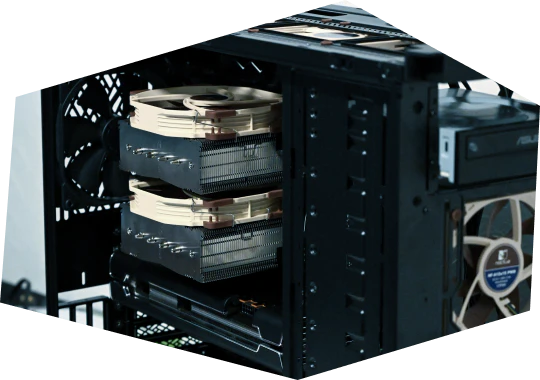Hyperconverged infrastructure (HCI)
Rethinking corporate IT – with a hyperconverged infrastructure
Manage an IT infrastructure as easily as a smartphone: no complicated server setups, just seamless integration of all components in a single, scalable solution. This is exactly what hyperconverged infrastructures (HCI) offer.


HCI changes the way IT infrastructures are handled
HCI is changing the way companies manage their IT resources. Unlike conventional infrastructures, a hyperconverged infrastructure is software-defined. This means that servers, computers and virtual machines, including storage and network solutions, are integrated and centrally controllable. This means that the entire IT infrastructure can be expanded or downsized with just a few clicks, depending on current requirements. Traditional infrastructures are based on a 3-tier model with separate components for servers, storage and network, which leads to greater complexity and management effort. Hyperconverged infrastructures, on the other hand, combine all resources in an integrated solution that is easy to manage and scale, allowing companies to reduce costs and effort.
Saving costs and optimizing IT management
A hyperconverged infrastructure offers various advantages that help companies to manage their IT resources more efficiently and reduce costs at the same time.
- Scalability: HCI improves scalability as the infrastructure consists of modular building blocks that can be easily added or removed. This allows companies to adapt their IT resources to requirements quickly and easily.
- Performance and efficiency: HCI increases the performance and efficiency of systems, resulting in faster response times and better overall performance. HCI is an adaptive solution that can meet the requirements of modern companies.
- Cost savings: HCI reduces the need for cost-intensive, specialized hardware and lowers operating costs.

HCI offers a wide range of use cases
Hyperconverged infrastructures play a central role in virtualization and the implementation of Virtual Desktop Infrastructure (VDI), as they significantly simplify the management and provisioning of virtual machines. In addition, HCI proves to be particularly effective in edge computing, where it enables efficient data processing close to the point of origin. It also offers robust solutions for disaster recovery and backup in the area of reliable data protection and information recovery.
Another important aspect is the support of DevOps practices, where HCI promotes agile development processes through a simplified infrastructure. This versatility is particularly evident when considering the combination of HCI and cloud computing. In hybrid cloud scenarios, HCI enables a seamless connection between on-premises resources and cloud services, allowing IT managers to utilize the flexibility of both approaches. HCI thus acts as a stepping stone to the cloud by supporting simplified migration and management of applications and data in hybrid environments. This combination of features makes hyperconverged infrastructures a future-proof solution for small and medium-sized enterprises looking to modernize and adapt their IT infrastructure.
HCI trends for 2024
The development shows a clear trend: the market is growing steadily and is expected to reach a volume of 32 billion US dollars by 2028, according to forecasts. This growth is being driven by the increasing demand for efficient and flexible cloud and edge solutions. One particularly promising area is the integration of HCI with AI and machine learning, which opens up new opportunities for automated and intelligent infrastructure management.
When deciding for or against a hyperconverged infrastructure, it is important to carefully assess the specific requirements, IT strategy and growth plans. Although HCI offers many advantages, it is not a universal solution. A thorough analysis of your infrastructure needs is crucial to finding the optimal solution. Ultimately, HCI is a particularly attractive solution for companies looking for a future-proof, flexible and efficient IT infrastructure.
How to find suitable cloud providers
gridscale combines the cost-effectiveness and scalability of the cloud with the performance, reliability and data security of an in-house data center. gridscale’s hyper-converged infrastructure enables companies to streamline their IT and accelerate key services. Through full virtualization, gridscale improves control over resources and performance, resulting in greater responsiveness to business needs. In this gridscale HCI e-paper, IT decision-makers will learn how they can help companies create a modern, efficient and flexible IT infrastructure.
